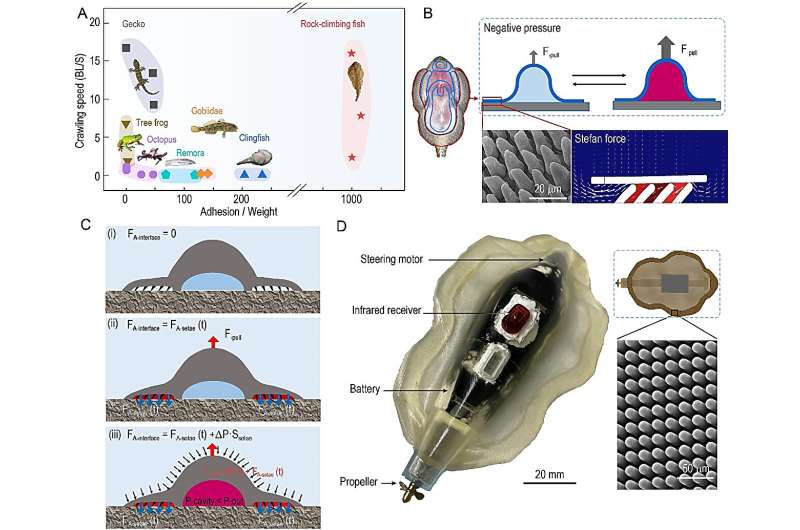This article has been reviewed according to Science X's editorial process and policies. Editors have highlighted the following attributes while ensuring the content's credibility:
fact-checked
trusted source
proofread
Unveiling the aquatic marvel: The rock-climbing fish and its adhesion-sliding feat

Underwater "traffic" encompasses a fascinating variety of creatures, from fish with their graceful swimming postures to jet-propelled jellyfish and remoras hitching rides on other organisms. Among these, a remarkable species known as the "underwater gecko," the rock-climbing fish (Beaufortia kweichowensis), stands out. This extraordinary creature possesses a unique set of abilities—it can swiftly slide along underwater surfaces like an ice skater, crawl against water currents, and securely adhere to a fixed position with remarkable adhesion force.
Recently, a collaborative effort between the research team led by Prof. Lianqing Liu at the Shenyang Institute of Automation, Chinese Academy of Sciences, and institutions including the Chengdu Institute of Biology, Chinese Medical University, Tsinghua University, and the University of Hong Kong, has shed light on the closely guarded secrets behind the rock-climbing fish's dynamic adhesion and rapid crawling movements.
The team has also designed an underwater biomimetic adhering-sliding robot inspired by the rock-climbing fish. This innovative robot can achieve tight adhesion on a moving ship model and slide smoothly underwater.
The research team highlighted that the Climbot's impressive adhesion ability enables it to cling with a force equivalent to 1,000 times its weight while accomplishing a remarkable glide at a speed of 7.83 times its body length per second.
The mechanism underlying this unique dynamic adaptive adhesion capability has long remained an enigma, intriguing researchers in the field of underwater robotics. Balancing substantial surface adhesion with agile and swift gliding poses a significant challenge, as increased adhesion often results in heightened surface contact stress.
Prof. Liu said, "Typically, reversible underwater adhesion relies on a negative pressure adhesion mechanism, a system adopted by rock-climbing fish as well. However, the mystery lies in the fact that other creatures such as remoras and octopuses, also utilizing negative pressure adhesion, cannot execute surface gliding like the rock-climbing fish."
The secret to the rock-climbing fish's exceptional adhesion-gliding prowess lies in the setae structures present on the edges of its suction cups. These setae, measuring 4-6 micrometers in diameter and 12-14 micrometers in length, convert the contact area with water into a "sticky" gel-like substance under the influence of Stefan force, firmly attaching the suction cups to the surface and creating a dynamic water seal.
This unique suction cup can passively deform its soft abdomen to counteract external detachment forces, or actively contract its abdomen to generate a powerful adhesion force, anchoring itself securely to a particular position. Moreover, the water film present at the contact interface acts as a "lubrication film" during movement, reducing frictional resistance and facilitating smooth surface gliding. This ingenious mechanism effectively balances the conflict between substantial adhesion and rapid sliding.
Drawing inspiration from this discovery, the research team successfully utilized micro-nano lithography and molding techniques to fabricate setae arrays, integrating them into 3D-printed soft suction cups, and incorporating a control unit to design and create the Climbot, an underwater adhering-sliding robot. The Climbot can tightly adhere to the surface of a moving ship model and glide effortlessly underwater.
This groundbreaking research showcases a novel underwater locomotion, and the potential applications of Climbot underwater suction-crawling robot technology hold promising prospects in the fields of marine science, underwater exploration, and ocean engineering.
The work is published in the journal National Science Review.
More information: Wenjun Tan et al, Uncover rock-climbing fish's secret of balancing tight adhesion and fast sliding for bioinspired robots, National Science Review (2023). DOI: 10.1093/nsr/nwad183
Provided by Science China Press




















